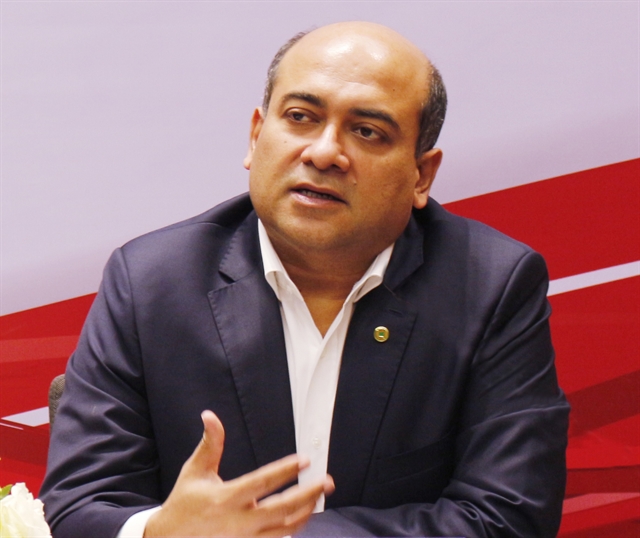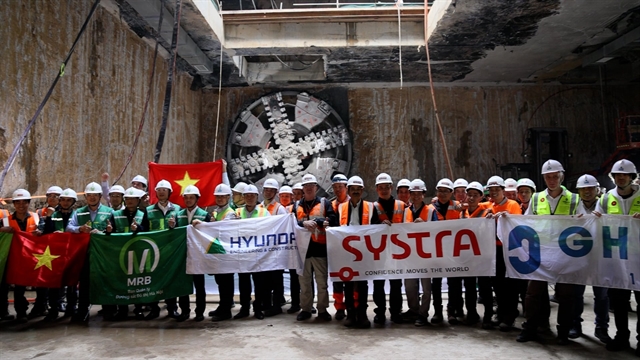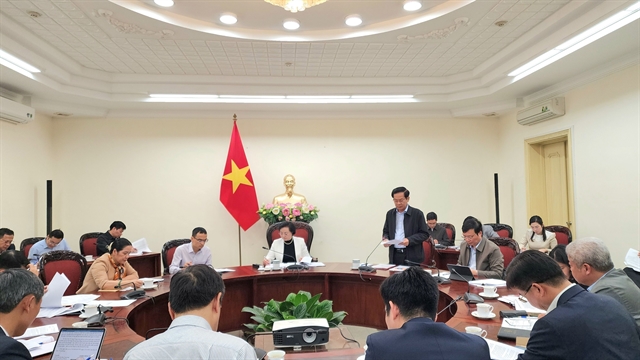 Economy
Economy

Along with the development of modern technology and retail sector, cashless payment is widely used in the country with the participations of many players from different sectors including banks, retail companies and cashless payment method providers. Việt Nam News reporter Thu Ngân talks with exclusives from companies to share their view about the development, the trend and the security of cashless payment in Việt Nam in the coming time.
Along with the development of modern technology and retail sector, cashless payment is widely used in the country with the participations of many players from different sectors including banks, retail companies and cashless payment method providers. Việt Nam News reporter Thu Ngân talks with exclusives from companies to share their view about the development, the trend and the security of cashless payment in Việt Nam in the coming time.
Sanjay Chakrabarty, deputy CEO, head of Retail Banking of Orient Commercial Bank (OCB)

|
Needless to say, in Việt Nam, the potential of cashless payments is very high. The acceptance of new technology backed by high penetration of smart phones among the young population makes the environment perfect for growth in cashless digital payments.
Cashless payments support financial transactions where we don’t use physical banknotes, but execute the transaction through electronic information transfer. The concept is very simple that way. So, to drive cashless payments, first and foremost, we need technological infrastructure and connectivity, and second, willingness of different parties to enable cashless transactions.
In Việt Nam, both these factors are on the rise. The Government has been extremely supportive of this endeavour. Also, given the penetration of smart phones and high ratio of early adaptors of technology, the private sector clearly recognises the potential of setting up payment platforms. So, it is not a surprise that the investments to enable cashless payments has come from both Government and private sector.
In the past, cashless payments were often associated with credit and debit cards. While the usage of cards has increased significantly over the years and quite a few banks have even launched contactless cards, adding to the convenience of customers, the focus of cashless payments has really moved to digital payments.
Digital payments are getting more and more frictionless.
It is true that the risk of fraud is higher in case of cashless payments. Cashless payments are executed through data transfer and whenever there is a data breach, the risk of fraud increases significantly. We have instances where the even banks, despite all the focus they have to keep their data secure, have been hacked.
However, the good news is Việt Nam has kept apace with developed countries when it comes to security.
There are two particular measures that have a significant impact on security. One, the shift to the chip card from magnetic stripe at the back of the card. The micro-chip makes the card far more secure than the traditional card as the card data stored in the terminal when one uses a chip card cannot be reused for future transactions. For online, now banks are moving to 3D security which means apart from the security code at the back of the card, one will require an OTP to complete the transaction. Both these changes will substantially increase security for financial transactions.
There is no 100 per cent safe payment, it’s always a trade-off; high risk comes with high return, more security comes with less convenience; cashless payment brings more conveniences to the people around the world and its safety depends on many factors such as laws and regulation, cashless payment policy, infrastructure maturity, payment network, and culture.
We can see Việt Nam has been improving those factors significantly in the past few years to make cashless payment more popular and secure, and Vietnamese now can enjoy the great benefits of cashless payment in their daily living, especially in urban areas.
Loic Gautier, co-founder and CEO of Leflair

|
More than 30 per cent of Leflair customers use cashless payment and the share is rapidly increasing. Cashless payment is beneficial for everyone. Not only it is safer and more convenient for both businesses and consumers, it contributes to building a more organised society by helping the different administrations with transaction records and fee collection.
Two barriers remain, however, to Việt Nam becoming a cashless society: first, the current market for mobile wallets in Việt Nam is not concentrated. Many different providers develop different solutions to serve their own service. Without more concentration by a smaller number of solutions, available at a large number of vendors, there can be no truly massive adoption. Second, although many players are offering solutions to customers that already have credit cards and access to banking, a great opportunity remains in technology solutions that do not require credit cards or even a bank account in order to address the needs of under-served populations outside the cities.
Trần Tuấn Anh, managing director of Shopee Vietnam

|
Consumers in Việt Nam still have a very strong preference for cash and delivery in terms of payment methods. The percentage of cash on delivery (COD) payment in Việt Nam is 65 per cent, eight times the world average (8 per cent), while the figures for debit and credit cards payment are trivial. But in some Asia countries like Singapore, there is very high credit card penetration and people there usually use credit cards, internet banking or even bank transfers for payment.
While COD is the preferred method for most Vietnamese customers, at the moment Shopee is looking at ways to help enhance our users’ shopping experience. One of them is by having an integrated payments system which offers various payment options such as COD or credit card, where users can easily and conveniently opt to pay for their purchases online. Shopee hopes to encourage more Vietnamese to move towards cashless payment modes.
Đặng Tuyết Dung, Visa Country Manager for Việt Nam and Laos

|
Việt Nam is unique right now as consumers are embracing digital payments as a faster and more convenient way to pay, and for many, their first experience of digital payment is from using mobile technologies rather than a “traditional” credit or debit card.
According to Visa’s Consumer Payment Attitudes study, the number of respondents in Việt Nam saying they have used in-app mobile payments increased to 44 per cent last year. This study also found that those saying they had tried contactless card payments increased to 32 per cent, and QR payments 19 per cent. So we are seeing some really positive growth across a range of different electronic payment mediums.
Cashless payments can be safer than using cash. Let’s say you have a wallet with VNĐ2 million in it, and it gets stolen; that money is almost certainly gone, unless you’re able to somehow track down the thief.
Now let’s say you have no cash in your wallet, but you have a card in it which is connected to an account that has, say, VNĐ22 million. As long as you call your bank to put a hold on that card, your money is safe, and what’s more, if the thief tries to use your card, then it can be traced and we have a better chance of holding them to account.
When comparing Việt Nam with the rest of Southeast Asia, you need to bear in mind that we’re trying to compare markets that are vastly different: the commercial environment in Việt Nam is vastly different to both Singapore and Laos. What I can say is that though Việt Nam is a relatively young market when it comes to electronic payments, we’ve seen very strong adoption by both merchants and consumers. This, coupled with our strong spending and transaction growth rate, positions Việt Nam as a very important market for us in the region.
We are passionate about helping grow and strengthen the Vietnamese digital economy, and in order for us to be able to achieve a cashless future, we need to ensure an incredibly high level of co-operation between consumers and financial institutions, merchants and other stakeholders.
Vũ Quốc Tuấn, head of Government Relations, Lazada Vietnam

|
A report from the Ministry of Industry and Trade said 82 per cent of e-commerce transactions are paid by COD. The remaining are shared between bank transfer, auto teller machine (ATM), credit cards and e-wallets. We hope in future consumers will become more and more familiar with cashless payment.
Cashless payment is much safer than cash because it is protected by banks and fintech companies using the highest encryption technology. In case of cash, you need to protect yourself from pickpockets and forgetting your wallet somewhere. To convince consumers, we believe that financial institutions must build trust, improve their technical infrastructure and continuously develop payment technologies using biometric and mobile devices. — VNS




